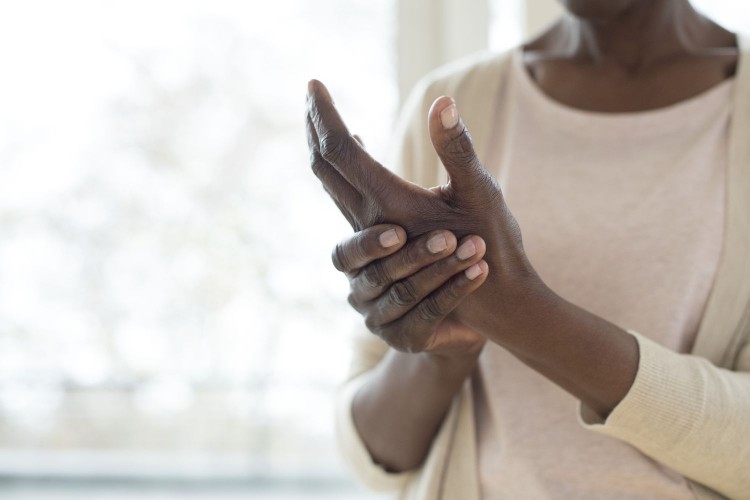Nearly 1 billion people will be living with osteoarthritis by 2050 if a new study's prediction comes true.
Osteoarthritis impacts 32.5 million adults in the U.S. and 7% of the world's population—or 500 million people. But the new research, published in The Lancet Rheumatology, indicates that by 2050 nearly 1 billion people will be living with this degenerative joint disease.
"The main reason we predict an increased burden for osteoarthritis by 2050 is because of demographic changes—in particular, a growing population of older individuals globally," said Jaimie Steinmetz, PhD MSc, lead research scientist at the Institute for Health Metrics and Evaluation.
Steinmetz explained that the new study proved that osteoarthritis becomes more common with age.
"About 3.5% of 30 to 60-year-olds experience osteoarthritis, which rises to over 40% as people get into their 80s," she said. "So as the global population ages, we will expect to see more cases of osteoarthritis if nothing else changes."
The research team also found that the cases of osteoarthritis—the most common form of arthritis in adults—have been increasing rapidly over the past three decades.
In 1990, 256 million people had osteoarthritis. By 2020, this number rose to 595 million people—a 132% increase from 1990.
By 2050, this number is projected to approach the 1 billion mark.

Getty Images / SCIENCE PHOTO LIBRARY
The new study was part of the Global Burden of Disease Study 2021 and used 30 years of osteoarthritis data in more than 200 countries to understand the rate of disease.
"We looked at three common sites of osteoarthritis—knee, hand, and hip joints—and a residual category for other joints such as shoulder or elbow," Steinmetz said.
The researchers discovered that the most common areas for osteoarthritis are the knees and hands. And, by 2050, they project that osteoarthritis will increase by the following percentages in these key areas of the body:
In addition to age and population growth, the study also showed that obesity also is an important risk factor for osteoarthritis.
Obesity has played a greater role over time in the development of osteoarthritis as rates of obesity have increased. For instance, in 1990, obesity was responsible for 16% of the disability due to osteoarthritis but rose to 20% in 2020.
However, if obesity can be addressed in the global population, Steinmetz notes that the burden of osteoarthritis could potentially decrease by as much as 20%. "Given osteoarthritis is so common and can cause pain and decreased mobility, we think it is a key condition to address," she said.
Generally speaking, osteoarthritis is caused by "wear and tear" damage to your cartilage—the cushion of all of your joints, said Sean S. Rajaee, MD, MS, director of the Outpatient Hip and Knee Center at Cedars-Sinai.
"More years of walking, running, and being active leads to more wear and tear and hence more osteoarthritis," he told Health.
Other factors that contribute to the development of osteoarthritis include genetics, prior injuries or fractures, and obesity, Rajaee explained. "Osteoarthritis often runs in families and being genetically pre-disposed to it is the most common reason," he said.
One older study notes that there is a 40% probability of inheritability in an osteoarthritic knee and a 65% probability of inheritability in osteoarthritic hands and hips.
Previous injuries can also play a role in the development of osteoarthritis later in life.
Injuries to your knee joint or the surrounding structures—such as meniscus damage, an ACL sprain or tear, or hamstring tendinopathy—can all later lead to osteoarthritis Sarah Trahan, NMD, a staff physician at the Neil Riordan Center for Regenerative Medicine told Health.
"Carrying heavy loads and being overweight also increases the force on your knees," she said. "For every pound overweight, there is a four times increase in pressure on your knee joint."
Your sex also can play a role in your development of osteoarthritis. According to Steinmetz and the World Health Organization osteoarthritis is significantly more common in females than males, with 60% of people living with the condition being women. He notes this is particularly true for hand and knee osteoarthritis.
"Research could be stronger to better understand this link, but from our understanding now, hormonal differences...can cause increased inflammation in joints," Trahan said, "and the dramatic decrease in estrogen as we age causes an imbalance in the homeostasis of joint tissue."
Additionally, Trahan pointed out that women usually face an increased quadricep angle, narrower femurs, thinner patellae, and a difference in tibial condylar size that can all contribute to osteoarthritis in the knees.
Although osteoarthritis is common in older adults, it isn’t inevitable. There are a number of things you can do to support your joint health as you age.
At the top of the list are building muscle strength, eating a nutritious diet, and addressing inflammation.
"Muscle strength is completely in our control," Trahan said. "The stronger we can make our bones, muscles, and ligaments that surround our joints, the more we can offload the forces causing cartilage degeneration."
She also recommends trying glucosamine and chondroitin, though the research on their effectiveness is mixed.
"Utilizing regenerative injection therapies and proper neuromuscular training will also help mitigate joint degeneration due to chronic inflammation and pain as well as avoiding the overutilization of steroid injections, which can progress cartilage degeneration," Trahan said.
Trahan stressed a few ways society can help prevent osteoarthritis:
Finally, controlling your blood sugar also can help prevent osteoarthritis.
According to the Arthritis Foundation, high blood sugar can speed the formation of certain molecules that make your cartilage stiffer and more sensitive to mechanical stress. Plus, having diabetes can trigger systemic inflammation that leads to cartilage loss.
"Maintain good nutrition and eat a balanced diet, including some anti-inflammatory foods," said Rajaee. "Osteoarthritis is an inflammatory condition and most treatment strategies target decreasing inflammation."